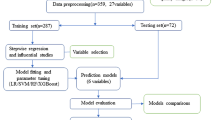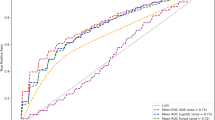Abstract
Atrial fibrillation (AF) represents a condition of irregularities of heartbeats. Timely diagnosis and treatment of AF are crucial to avoid serious consequences such as stroke, heart failure and death. AF is detected from patient’s rhythm data as a binary longitudinal sequence. In this article, we introduce an approach for analyzing the binary longitudinal sequence of AF. Our approach is based on gradient boosting, a machine learning approach. We use multivariate tree as a base learner to model complex relationships between multiple covariates and response. In order to model covariate-time interactions, we use B-spline. Application of our approach to a randomized trial data provides the importance of surgical ablation in the treatment of AF among patients with persistent or long-standing persistent AF. Comparison of prediction performance of our approach with other methods using randomized trial data and simulated data shows that our approach has a better prediction performance. Variable selection using variable importance has identified duration of AF as an important covariate that has strong interaction with post-surgery time. This helps to identify patients’ variability and groups of patients who derived the most benefits from the treatment. Our method can be implemented using the R package boostmtree.







Similar content being viewed by others
References
Go AS, Hylek EM, Phillips KA, et al. Prevalence of diagnosed atrial fibrillation in adults: national implications for rhythm management and stroke prevention: the AnTicoagulation and Risk Factors in Atrial Fibrillation (ATRIA) Study. J Am Med Assoc. 2001;185(18):2370–5.
Gillinov A, Argenziano M, Blackstone E, Iribarne A, DeRose JJ, et al. Designing comparative effectiveness trials of surgical ablation for atrial fibrillation: experience of the Cardiothoracic Surgical Trials Network. J Thorac Cardiovasc Surg. 2011;142(2):257–64.
Liang KY, Zeger SL. Longitudinal data analysis using generalized linear models. Biometrika. 1986;73:13–22.
McCulloch CE, Searle SR. Generalized linear and mixed models. New York: Wiley; 2001.
Giltinan D, Davidian M. Nonlinear models for repeated measurement data. London: Chapman & Hall; 1995.
Ganesan R, Dhanavanthan P, Kiruthika C, Kumarasamy P, Balasubramanyam D. Comparative study of linear mixed-effects and artificial neural network models for longitudinal unbalanced growth data of Madras Red sheep. Vet World. 2014;7(2):52–8.
Mandel F, Ghosh RP, Barnett I. Neural networks for clustered and longitudinal data using mixed effects models. Biometrics. 2021. https://doi.org/10.1111/biom.13615.
Wood SN. Low rank scale invariant tensor product smooths for generalized additive mixed models. Biometrics. 2006;62(4):1025–36.
Pande A, Li L, Rajeswaran J, Ehrlinger J, Kogalur UB, Blackstone EH, Ishwaran H. Boosted multivariate trees for longitudinal data. Mach Learn. 2017;106(2):277–305.
Pande A, Ishwaran H, Blackstone E. Boosting for multivariate longitudinal responses. SN Comput Sci. 2022;3:186. https://doi.org/10.1007/s42979-022-01072-6.
Tutz G, Reithinger F. A boosting approach to flexible semi parametric mixed models. Stat Med. 2007;26(14):2872–900.
Yue M, Li J, Cheng M-Y. Two-step sparse boosting for high dimensional longitudinal data with varying coefficients. Comput Stat Data Anal. 2019;131:222–34.
Tutz G, Groll A. Generalized linear mixed models based on boosting. In: Statistical modeling and regression structure. Heidelberg: Physica-Verlag; 2010. p. 197–215.
Groll A, Tutz G. Regularization for generalized additive mixed models by likelihood-based boosting. Methods Inf Med. 2012;51(2):168.
Hothorn T, Buhlmann P, Kneib T, Schmid M, Hofner B. Model-based boosting 2.0. J Mach Learn Res. 2010;11:2109–13.
Buhlmann P, Yu B. Boosting with L\(_2\) loss: regression and classification. J Am Stat Assoc. 2003;98(462):324–39.
Friedman JH. Stochastic gradient boosting. Comput Stat Data Anal. 2002;38:367–78.
Friedman JH. Greedy function approximation: a gradient boosting machine. Ann Stat. 2001;29:1189–232.
De Boor C. A practical guide to splines. Berlin: Springer Verlag; 1978.
Breiman L, Friedman JH, Olshen RA, Stone CJ. Classification and regression trees. Belmont: Wiley; 1984.
Ishwaran H, Kogalur UB. Random Forests for Survival, Regression and Classification (RF-SRC), 2022. R package version 3.0.2.
Eilers PHC, Marx BD. Flexible smoothing with B-splines and penalties. Stat Sci. 1996;11:89–102.
Lu M, Ishwaran H. A prediction-based alternative to P values in regression models. J Thorac Cardiovasc Surg. 2018;155:1130–6.
Gillinov AM, Gelijns AC, Parides MK, DeRose JJ Jr, Moskowitz AJ, et al. Surgical ablation of atrial fibrillation during mitral valve surgery. N Engl J Med. 2015;372(15):1399–408.
Ishwaran H, Pande A, Kogalur U.B. boostmtree: boosted multivariate trees for longitudinal data, 2022. R package version 1.5.1.
Lunn AD, Davies SJ. A note on generating correlated binary variables. Biometrika. 1998;85(2):487–90.
Sela RJ, Simonoff JS. RE-EM trees: a data mining approach for longitudinal and clustered data. Mach Learn. 2012;86:169–207.
Funding
This work is supported in part by R01 HL103552 and by a cooperative agreement (U01 HL088942) with the National Heart, Lung, and Blood Institute, including funding by the National Institute of Neurological Disorders and Stroke and the Canadian Institutes of Health Research. Clinicaltrials.gov Identifier: NCT00903370.
Author information
Authors and Affiliations
Corresponding author
Ethics declarations
Conflict of interest
All authors declare that they have no conflict of interest.
Additional information
Publisher's Note
Springer Nature remains neutral with regard to jurisdictional claims in published maps and institutional affiliations.
Supplementary Information
Below is the link to the electronic supplementary material.
Rights and permissions
Springer Nature or its licensor holds exclusive rights to this article under a publishing agreement with the author(s) or other rightsholder(s); author self-archiving of the accepted manuscript version of this article is solely governed by the terms of such publishing agreement and applicable law.
About this article
Cite this article
Pande, A., Ishwaran, H., Blackstone, E. et al. Application of Gradient Boosting in Evaluating Surgical Ablation for Atrial Fibrillation. SN COMPUT. SCI. 3, 466 (2022). https://doi.org/10.1007/s42979-022-01350-3
Received:
Accepted:
Published:
DOI: https://doi.org/10.1007/s42979-022-01350-3




